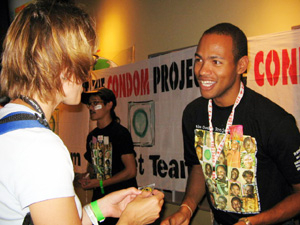News
What Works in HIV Prevention: Engaging Young People
- 14 August 2006
News
TORONTO, Canada — Three days before the XVI International AIDS Conference officially opened, youth delegates were preparing themselves to be more powerful advocates.
In the stately gothic buildings of the University of Toronto’s leafy campus, the 250 young people who comprise the Toronto YouthForce were studying policy and trade issues that affect HIV prevention and treatment. They were mastering the latest research and statistics about the epidemic. They were exchanging information and forging alliances. They were rehearsing what they would say if they found themselves in an elevator with an important diplomat.

The YouthForce network includes some of the most promising leaders from perhaps a hundred organizations and fifty countries. As Steve Kraus, chief of UNFPA’s HIV/AIDS branch declared at the opening of the Chasing the Dream Exhibit: “You have something special or you wouldn’t be here.”
Clearly this is a force to be reckoned with: Ranging in age from 16 to 26, YouthForce members are all raising awareness in their communities about HIV and AIDS. They work in clinics and schools, in small organizations and UN agencies, in radio and television, in orphanages and hospices. They display a sophisticated understanding of the epidemic (see box below) and an inspiring willingness to deal with it.
“Cynicism,” said one, “is not an option.”
“I was raised to fight for a world that will be free of HIV.”
“I’ve lost friends and family to this epidemic. This is very serious to me: it’s more than a job.”
“What we're seeing here is the formation of leaders and committed agents of change,” said Mary Otieno, technical adviser for HIV/AIDS and young people at UNFPA. “The young people we’re sponsoring will translate what they learn here into action in their own countries. These are the people who will shape the future of the epidemic.”
The YouthForce is just one of several youth networks that are represented at the conference. Youth played an important role the last four international AIDS conference, and the size of the youth delegation has more than doubled at each. Altogether, one of every 25 delegates, about 1,000 people in all, are under the age of 26. The conference programme includes 18 youth-specific sessions and 40 different activities at the Youth Pavilion.
“Why focus on young people?” asked a presenter at one pre-conference event.
“Because we’re the next generation,” said one person.
“We’re the most affected.”
“We think we’re invincible, but we’re not.”
The AIDS epidemic has demonstrated that no one, not even these young people who seem so resilient and so strong, are invincible. In 2005, nearly half of all new HIV infections were among people younger than 25. In that one year alone, the lives of some 5 million young people – the equivalent of the entire population of Toronto – were altered by most deadly virus in human history. Young women face the highest risk. The importance of reaching these young people was stressed by speaker after speaker.
“It’s going to take another generation to control the AIDS epidemic,” Dr. Peter Piot, the Executive Director of UNAIDS said at the Youth Opening and Reception on Saturday night. “You’re that generation.”
Piot was one of the busiest people in Toronto as the conference got underway. But on Saturday evening, and then again on Sunday morning, he addressed what he clearly considers to be a critical constituency.
“We know that prevention works among young people,” he said at the youth opening reception. “We’ve seen prevalence rates declining among young people in many places where interventions are in places. It’s proving a lot easier to change the behaviour of young people than of older men.”
Unless young people are at the table when plans are being made, programmes are unlikely to be successful, Piot added, and he vowed to give them a more formal role in decision-making. At a panel discussion the following morning, he praised UNFPA for its extensive work with young people. “We should all take a look at what UNFPA is doing, having youth internships in their offices,” he said. “It’s not only good for young people; it’s good for the organization.”
Throughout the week, UNFPA is supporting numerous youth activities. Several groups, including the Y-Peer Network and the African Youth and Adolescent Network on Population and Development, are hosting events and booths in the Global Village area of the convention hall. Throughout the week, they are performing and presenting and networking and passing out materials.
The Chasing the Dream photo exhibit, which portrays the intersection of eight young people with Millennium Development Goals will be on display. On Sunday afternoon, Richard Gere and producers from MTV Staying Alive briefed eight teams of young filmmakers, all of whom are youth delegates, about the challenge ahead: to write, shoot and edit a short film in just two days on an assigned subject. The results of the 48 Hour Fest will be screened on the evening of 17 August.
— Janet Jensen